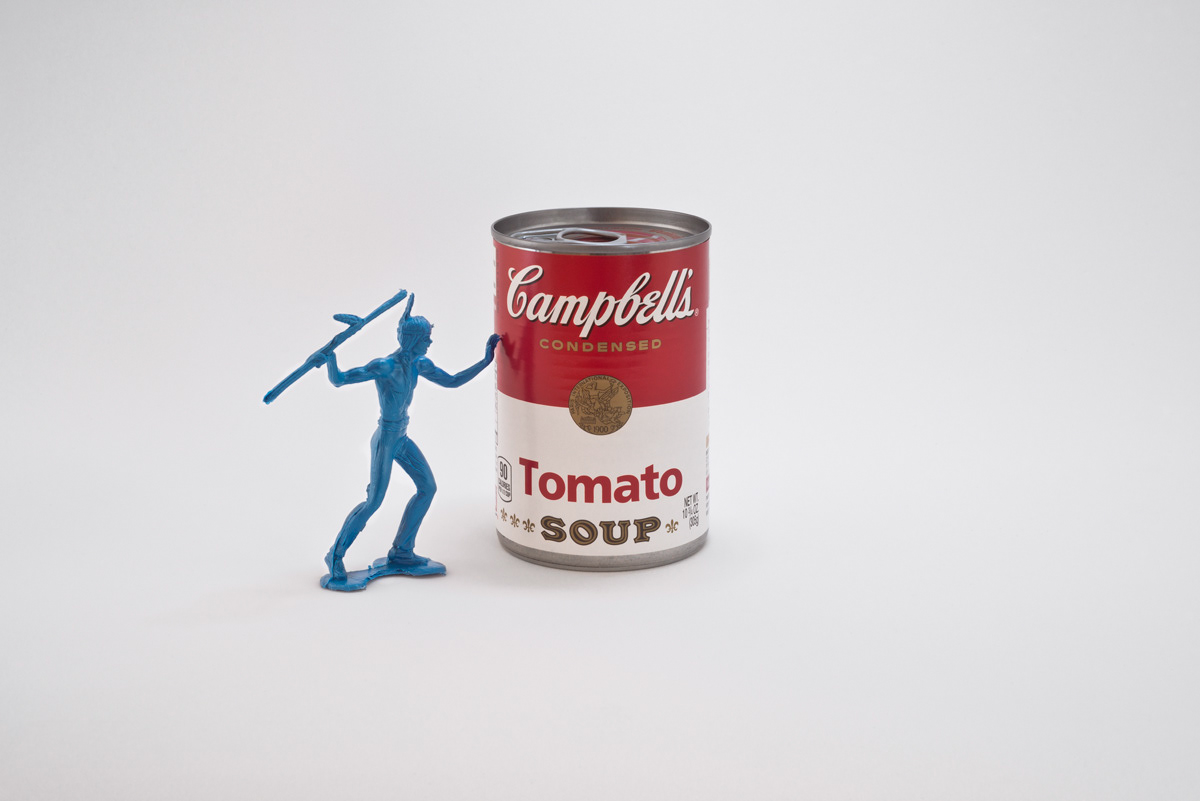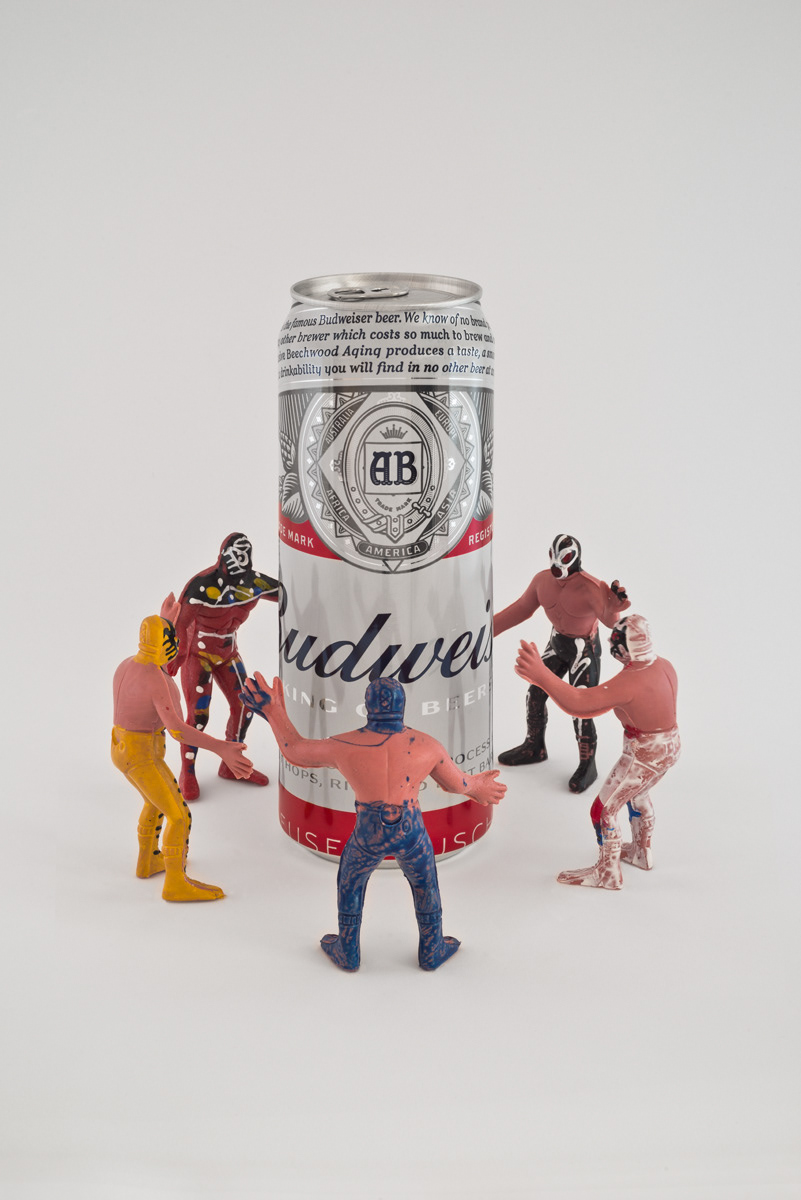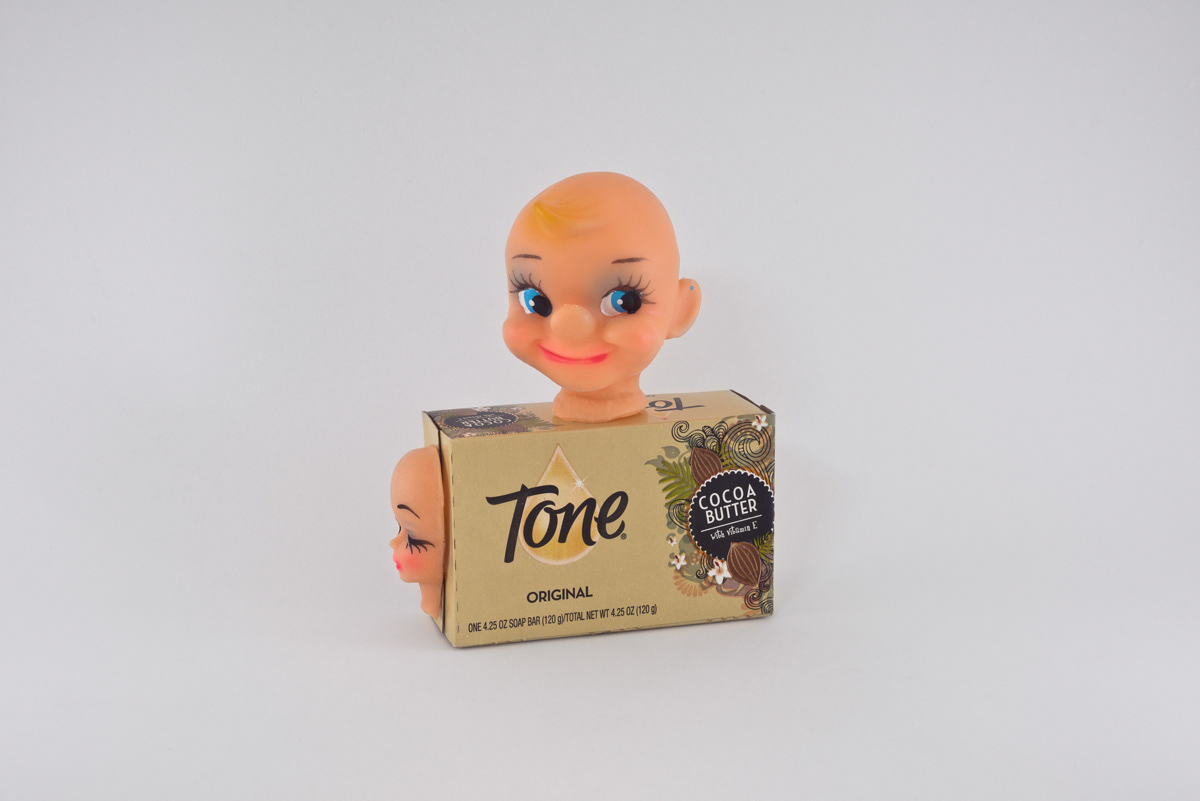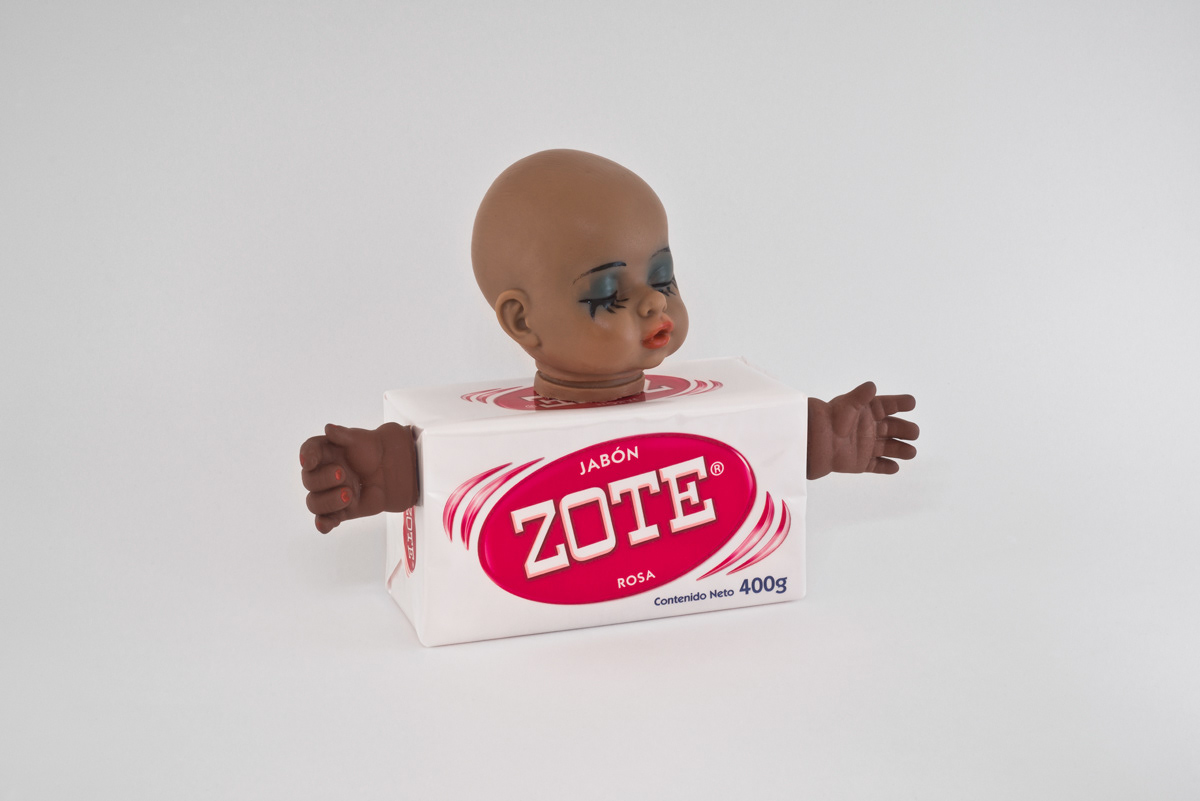#needforgood(s) is a series of photographs that explore the relations which generate from two visual elements: Consumer goods allusive to pop iconography and plastic toys acquired in flea markets.
I use play as the main tool to stage scenes that interweave the set of relations that emerge from the play between both elements. These images are the result of a ludic action and, like all games, fulfill the goal to explore reality as an essay. Bonds detach and concepts generate from this experimentation, which give a sense of meaning and strengthen the reality we observe.
The actions arranged in these sets are subtle representations of diverse situations that, latent under socio-cultural layers, are unveiled with a sense of humor and a touch of irony. With the use of modern publicity techniques, I propose a recontextualization of the previously appropriated objects to create new products that possess a double reality.
With this series I propose to observe the image from a parallel look to the cliché of a commercial product shot.
Rafael Blando, March 2019
Work exhibited in "Museo de la Moneda" in Torreon, Mexico from September 2019 trough January 2020. - Solo show
& in the "Museo Casa del Cerro" in Torreon, Mexico from October 2022 to December 2022 - Collective show
Series constituted by 22 gicleés over 230 grs. archival matte paper, each one 90x60 cms.
5 Limited edition prints available for sale.
5 Limited edition prints available for sale.
(NFG01) Coca-Cola

“We’re an empire now, and when we act, we create our own reality … We’re history’s actors … and you, all of you, will be left to just study what we do” – George Bush’s adviser in an interview with Ron Suskind (2002).
Coca-Cola is recognized as one of the most successful brands around the world, its logo is considered one of the most recognizable in the history of advertising. In 2018 Coca-Cola reported revenue for $23.4 billion dollars, this positioned it as the sixth most valued brand in the world, to achieve this Coca-Cola spent $4 billion dollars in advertising. Since its creation in 1984 The Coca-Cola Foundation has invested more than $1 billion dollars in social programs.
Sources:
(NFG12) Coke Diète

According to the OECD United States and Mexico have the highest overweight rates in the world, 38.2% and 32.4% respectively. These percentages have increased by almost 25% since the 60’s decade. Evidence strongly suggests that this increment is related to a shift in the general diet of the last fifty years, due to the growth of consumption in: sugar beverages, processed and canned food, among others. The OECD estimates these values will grow 10% by 2030.
Sources:
(NFG02) Campbell's Tomato Soup

“Your have to keep making it clear to your colleagues that CSR is not three hugging. It’s a way to improve the business.” – Dave Stangis (CSR corporate vice president in Campbell’s)
In 2009 Campbell’s saved $1.5 million dollars with its sustainable packaging program; at the same time they saved 250 tons of raw material. With the elimination of 1,700 trucks from their transportation network they saved 226,000 gallons of fuel. It was projected to save $1.2 million dollars with the use of a water and heat optimization system in one plant; at the same time they would save millions of gallons of water per week. In 2018 Campbell’s was ranked the 12th position within the “100 best companies with CSR” in the United States.
Campbell’s was the first company licensed to sell genetically engineered food products (Flavr Savr tomato).
“Silver car crash (double disaster)” is an Andy Warhol’s oeuvre that sold for $105.4 million dollars in 2013 at a Sotheby’s auction. “Small Torn Campbell’s Soup (Pepper Pot)” was sold for $11.7 million dollars in an auction in April 2019.
“I don’t think art should be for the select few. I think it should be for the mass of the American people.” – Andy Warhol.
Sources:
(NFG03) Campbell's Chicken Noodle Soup

(NFG18) Goldfish

Genetically modified food (GMO) is relatively recent so it is very difficult to assess the real effect on the human being. It’s believed that the consumption of this food generates antibiotic-resistant diseases; it’s also known that GMO crops have developed immunity to pesticides, like glyphosate, an agent that is considered by the WHO as a probable carcinogen.
Some believe that the increment in the production of GMO will make the developing countries more dependent of industrial countries because it’s likely that they could control food production. Monsanto controls 90% of the GMO seeds market in the world and after the acquisition by the giant Bayer in 2018, in a transaction valued in $63 billion dollars, they control 29% of the global seeds market and 24% of the pesticides one.
Pepperidge Farm affirms that its “Goldfish” crackers are organic and are made with non-GMO ingredients.
Sources:
(NFG06) Lindt Gold Bunny

“Money is gold, and nothing else.” – J.P. Morgan (1912)
The Federal Reserve Bank of New York and the Bank of England are the main gold depositories in the world. The countries with more gold reserves are: United States, Germany, Italy, France, Russia and China. In the past few years some of these countries have started to repatriate most of their gold reserves, but not without difficulties, this has lead some to speculate about the physical existence of gold within the international depositories (specially the Federal Reserve Bank of New York).
Banxico declared to own 119.9 tons of gold as its national reserve, most of it deposited in the Bank of England. Several irregularities and the hermeticism of Banxico regarding national gold reserve has lead some to speculate that México only counts with the so-called “paper gold” in its international reserves.
Sources:
(NFG06) Marlboro Red Label

“If the copy is an artwork, then what’s the original?” - Randy Kennedy (NYT, 2007).
In the 80’s Richard Prince started to exhibit re-photographed pieces from “The Marlboro man” ad campaign, by eliminating texts, re-framing the images and suppressing the references to the brand he presented the artwork as his own. His intention was to question key issues in art like: authorship, originality and the meaning of images. For some critics his artwork was understood as an appropriation and deconstruction of the West American iconography, for others, it was taken just as a burden art “piracy”. One of his re-photographs was sold in $1.2 million dollars in 2005.
Sources:
(NFG06A/B) Marlboro Red Label [Variation I]


In 1950 started one of the most successful ad campaigns in the century, “The Marlboro man” changed the target market of the brand towards a consumerist product targeted to men, sales increased by 3,000% and a revenue of $20 billion dollars was reported in 1957.
At least four of the actors that performed “the Marlboro man” died by tobacco related diseases: Erik Lawson (Chronic pulmonary obstruction, 2014), David McLean (Pulmonary cancer, 1995), Wayne McLaren (Pulmonary cancer, 1992) and David Millar (Pulmonary emphysema, 1987). The ad campaign ceased in 1998 when the United States Attorney General prohibited the use of humans in advertising for tobacco related products.
Sources:
(NFG13) Corona Extra

Speaking of global beer consumption Mexico ranks the sixth place, being China and United States the largest markets in 2018. Grupo Modelo was acquired in the first half of 2018 by Anheuser-Busch InBev in a transaction valued in $20,100’000,000 dollars.
Sources:
(NFG14) Budweiser

In 2016 Business Insider declared that in 2004 ten companies controlled 51% of the beer market around the world; ten years later only five companies own the same market. Anheuser-Busch InBev, being the largest, sells more than 1 out of 4 beers consumed in the world and reported revenue for $54.62 billion dollars just in 2018.
Sources:
(NFG07) Starbucks

In 2021 Starbucks reported revenue for $29.06 billion dollars worldwide. In the first half of 2022 they achieved a record revenue of $8.2 billion dollars, this due to the customization of cold beverages, which represent 75% of the total sales. The main consumers of these beverages are young people who belong to Z generation; they have a wide spread practice to personalize their beverages so they can post them in social media. Starbucks is at the vanguard of product customization and social media manage with the intent to increase their sales.
Examples of sugar content in Starbucks cold drinks: Venti Iced Tazo Chai Tea Latte (51 grs.); Venti Iced Hazelnut Mocha with whipped cream (79.5 grs.); Venti Mocha Frappuccino with whipped cream (56.9 grs.); Venti Mango Passion Fruit Frappuccino (54.3); Grande Coffee Frappuccino (40.5 grs.). As reference, a can of Coca-Cola has 33 grams of sugar.
(NFG15) Crystal Geyser Alpine Spring Water

Cherokee National Forest is located in the east of Tennessee and was created in an effort to protect natural resources, especially water pureness and quality. It is the house of more than 2,000 flora and fauna species. Nowadays it’s listed by the SELC as one of the 10th most endangered reserves in the US. This national forest is one of the seven natural sources and protected reservations where Crystal Geyser water is bottled. CG Roxane LLC affirms to be a family owned enterprise committed to support and protect the local communities and its natural resources.
Sources:
(NFG16) FIJI Natural Artesian Water

97.5% of world water is salted or has been contaminated. Of the 2.5% left, 70% is frozen in glaciers; this means that less than 0.01% of the world water is available for human consumption. One billion people in the world do not have access to this vital resource.
While 53% of the Fiji’s Republic population does not have access to water for personal consumption, Fiji’s bottling plant produces 50,000 water bottles per day and it’s exclusively destined for export. Water Fiji Foundation was created in 2007 in an effort to support the local communities in the islands of Fiji. The company, based in Los Angeles, owns the legal rights over the word “Fiji”.
Sources:
(NFG10) Tone Cocoa Butter

Among Afro-American population skin tone plays a key role in the life of the individual. It’s used to create prejudice and socio-economic hierarchies among community members; being the lighter skin tone the one that has accesses better benefits and opportunities. In the Bahamas the Afro-American community uses cocoa soap to remove blemishes and clear skin tones.
Post-colonialism and the billionaire beauty industry, supported by advertising, have dictated universal beauty canons. These ad campaigns, with the use of abstract language, promote the ideal of a lighter skin as a symbol of power and social status; this excludes most of the world’s population. It’s estimated that by 2024 the income of the bleach creams market will reach $31.2 billion dollars.
This form of discrimination is called “colorism” and affects societies around the globe.
Sources:
(NFG11) Jabón Zote Rosa

In 2013 Aeromexico, through a contracted modeling agency, seek actors with the “Polanco look” for the casting of an ad campaign. They exactly looked for: white skin, high socio-economic status, no blondes, no blue eyes and no dark skinned, among others.
In a 2017 study performed by INEGI for the first time some data emerged about discrimination indexes in Mexico. About 6% of lighter skin population has access to a directive or management position, while only 2.8% of darker skin population has access to the same job. 21% of the professionists or technicians in the country are lighter skin, while 12% of darker skin population has same employment. 28% of lighter skin population labors in the agricultural and service sectors, while 44% of darker skin population are employed in these tasks. 30.4% of lighter skin population has completed higher education, while only 16% of darker skin population has achieved it.
Other numbers from the National Council to Prevent Discrimination suggest that 20% of Mexicans are not satisfied with their skin tone, 25% says to have felt discriminated by their physical appearance and 55% recognizes that its an insult to call people by their skin tone.
Sources:
(NFG25) #blacklivesmatter [a]

(NFG26) #blacklivesmatter [b]

“… Whiteness is not acknowledged as a racialized/ethnicized positioning at all. Whiteness is generally seen as so ordinary, so lacking in characteristics, so normal, so devoid of meaning…”
“…The racialized discourses constructing blacks as inferior, intellectually backward, lazy, sexually insatiable, and always available…”
“…The supposedly most innocent terms for different sections of the population are racializing, without having to utter distasteful racial terms.”
“The claim of innocence, however, is a double-edged sword: it contains not-knowing, but also not wanting to know… This not-understanding, which can afflict white and nonwhite people alike…”
Sources:
Wekker, Gloria. White Innocence: Paradoxes of colonialism and race. 2016. United States of America. Duke University Press.
(NFG17) Virgen de Guadalupe

In 2002 Chinese businessman Wu You Lin patented before IMPI (Mexican Institute of Industrial Property) a version of “Our Lady of Guadalupe”; registration cost $2,112 MXN. Expired on February 29, 2012 because it was never renovated, as marked by the industrial property law.
In 2003 Proceso magazine stated that Diego Monroy, principal of Basilica de Guadalupe, sold for a sum of $12.5 million dollars the “intellectual property” of the Guadalupana image to Viotran. The American company would commercialize worldwide any article related to it for a period of five years.
In 2011, after an eight-year litigation, the National Supreme Court of Justice ruled in favor of Distroller Company (Virgencita Plis) about a complaint filed by Mercedes Gentz (Guadalupana niña) for the supposed plagiarism of an “Our Lady of Guadalupe” design.
In Mexico, according to criminal law, the image of “Our Lady of Guadalupe” is not an artistic artwork created by a physical person, but attributed to a deity, therefore it cannot be processed by that law.
Sources:
(NFG23) Baby Cowboy

(NFG24) Baby Apache

(NFG27) Baby Bomber

© Rafael Blando Torres


